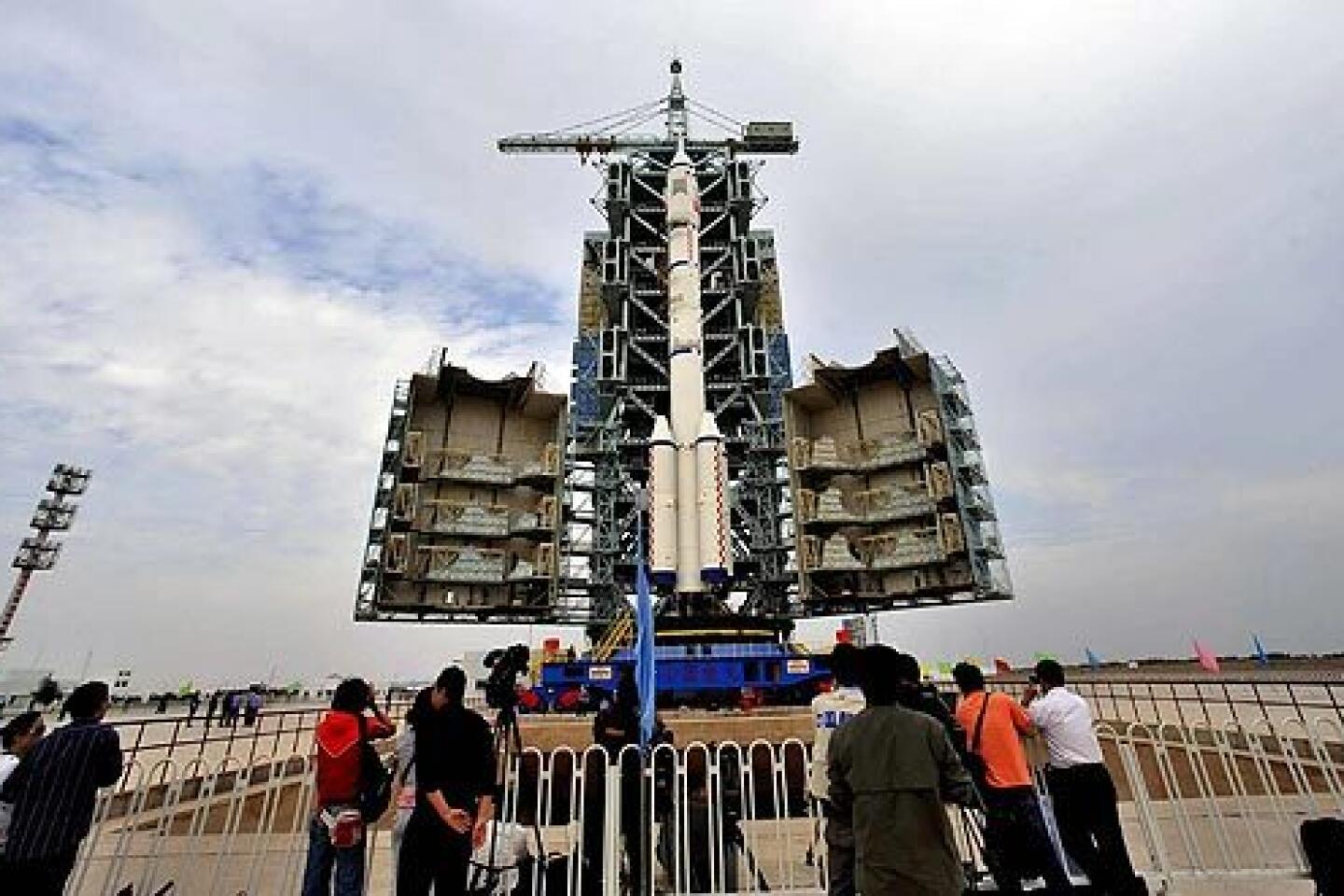China’s latest manned rocket mission to include spacewalk
BEIJING — China is scheduled today to launch its most ambitious space mission, including the program’s first spacewalk, as this increasingly confident nation stakes a claim on the heavens while impressing people on Earth.
The Shenzhou 7 is slated to blast off from the Jiuquan launch pad in Gansu province this evening, with the walk scheduled for 4:30 p.m. Friday, ground operations head Cui Jijun said, state media reported.
The nation’s third manned mission will carry three astronauts, or taikonauts,as they are known here; mission leader Zhai Zhigang will make the 40-minute spacewalk, which will be broadcast live.
Experts said this mission is the next logical step toward a Chinese space station and possible moon landing. Having put people in orbit and returned them safely, China is planning spacewalks, then rendezvous and docking operations, and subsequently deployment of a relatively modest space lab, followed by a more permanent space station.
“It’s a step-by-step development of their capability designed to have humans work in space, and this is a perfectly logical step,” said John Logsdon, director of the Space Policy Institute at George Washington University. “The world will be impressed by the spacewalk.”
Analysts said that though the mission has little obvious strategic or military benefit, it sends a signal to the world and particularly to regional space rivals Japan and India.
“It’s mainly for prestige,” said James Andrew Lewis, a senior fellow at the Center for Strategic and International Studies in Washington. “And regionally, China is wiping the field. India and Japan not only haven’t gotten their first guy in space, now China is doing a walk.”
China has made much of the fact that the spacesuit its taikonauts will use, dubbed the Feitian after a mythological flying god, is made completely with Chinese technology. But experts say the suit, reportedly developed at a cost of $23 million over a seven-year period, resembles the Orlan model Beijing bought from Russia.
In fact, both garments may play a role. According to the official New China News Agency, the mission’s second in command, Liu Boming, will don the Orlan to assist and presumably be on call as the Feitian-clad Zhai walks in space.
U.S. and European Union export restrictions on sensitive technology mean China has often had to adapt Russian technology or develop homegrown solutions.
Zhai will be tethered to the spacecraft rather than use a self-propelled jet pack of the sort employed in U.S. missions. He is not expected to perform any complex tasks. Chinese media refer to his “tightening bolts,” but this may be to provide him with something to do while the camera rolls.
Compared with NASA, which has been hurt by lackluster public support, pinched budgets and high-profile accidents, the Shenzhou program enjoys broad horizons. The program is a source of enormous pride among ordinary Chinese. And China’s leadership sees it as an important way to unify the people and strengthen support for the ruling Communist Party, according to some political analysts.
China’s program has often been shrouded in secrecy.
“We still need to work on transparency,” said Jiao Weixin, Earth and space sciences professor at Peking University. “I don’t think it’s necessary to make it so secretive.”
However, as China has met or exceeded expectations with its space program, its confidence has increased. Launches are now routinely televised live.
Although spacewalks are not a new feat -- Russia and the United States first performed them decades ago -- the maneuver remains risky given the complexity of air locks and the harsh space environment.
One of the more interesting aspects of the mission will be the launch of a small satellite designed to travel alongside the Shenzhou 7 and transmit images of the craft back to Earth. This is a potentially tricky operation given the proximity of the two objects and may be a warmup for future rendezvous and docking missions.
“At that speed in space, it’s not easy to do,” said Eric Hagt, China program director with the Washington-based World Security Institute.
“This will be the first time they really take pictures of a Chinese astronaut in space,” he added. “You can imagine the flags everywhere. . . . Post-Olympics, this is another accomplishment. It’s a public relations event.”
China has been methodical in crafting the building blocks of its increasingly ambitious Shenzhou program and has never suffered a fatality. But the danger of live broadcasts and enhanced public relations strategies, as NASA has learned the hard way, is that all the attention can backfire if something goes wrong.
China’s eventual goal of building a space station dovetails with a bid to expand its influence on the world stage, signaling that it is playing in the big leagues with Russia and the United States.
“A lot of countries have satellites,” Hagt said. “But if you have a space station, it says, ‘We have a serious claim in space.’ ”








